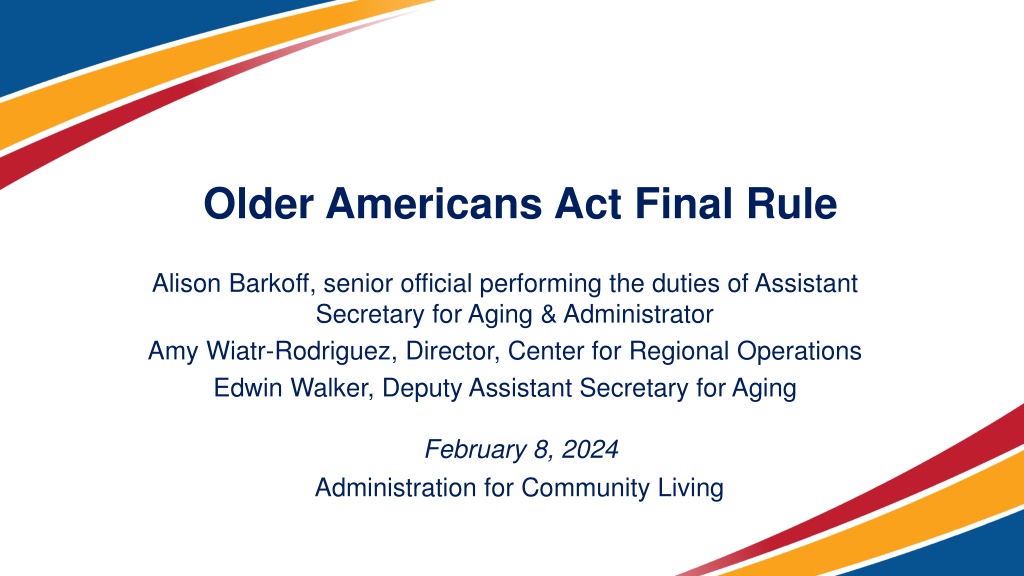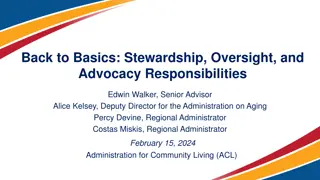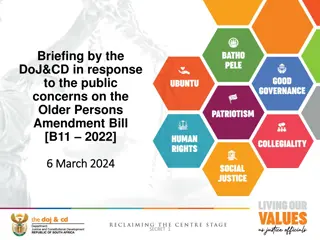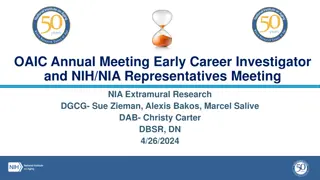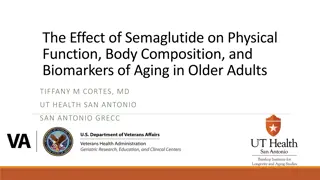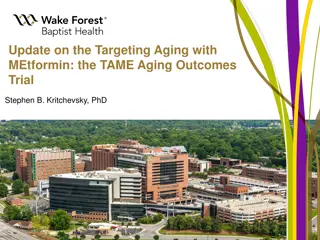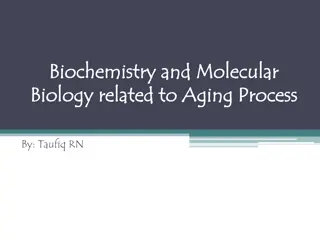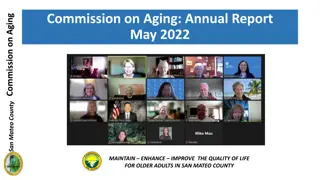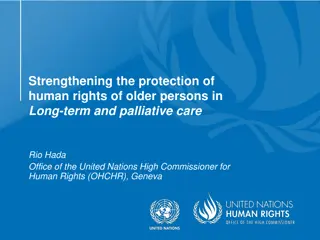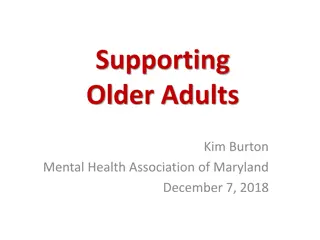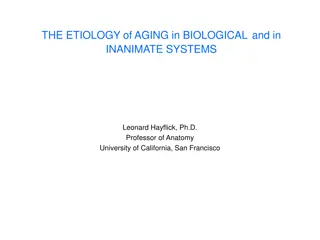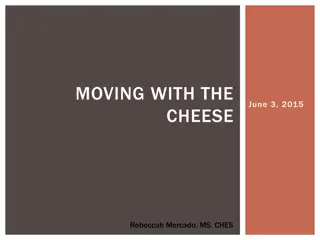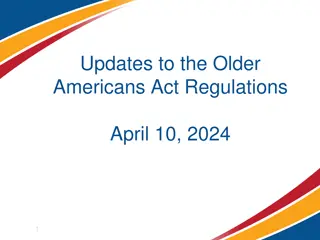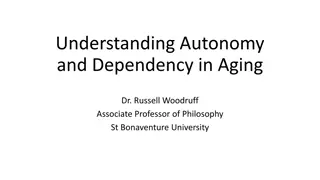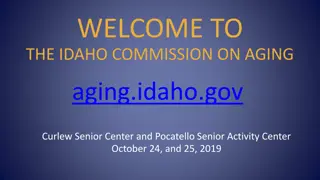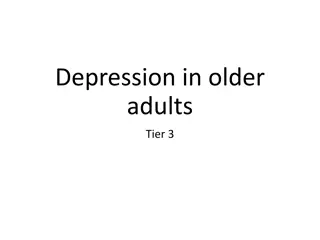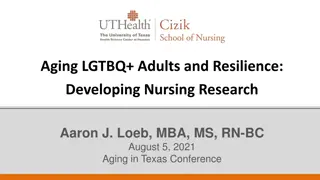Understanding the Older Americans Act and Its Impact on Aging Services
The Older Americans Act (OAA) plays a vital role in providing programs and services to support older adults in aging-in-place. This act authorizes various initiatives such as meal assistance, caregiver support, health services, and more to enhance the well-being and independence of older individuals. Learn about the key provisions, regulations, and the mission of the Administration for Community Living (ACL) in ensuring the dignity and autonomy of aging populations.
Download Presentation

Please find below an Image/Link to download the presentation.
The content on the website is provided AS IS for your information and personal use only. It may not be sold, licensed, or shared on other websites without obtaining consent from the author. Download presentation by click this link. If you encounter any issues during the download, it is possible that the publisher has removed the file from their server.
E N D
Presentation Transcript
Older Americans Act Final Rule Alison Barkoff, senior official performing the duties of Assistant Secretary for Aging & Administrator Amy Wiatr-Rodriguez, Director, Center for Regional Operations Edwin Walker, Deputy Assistant Secretary for Aging February 8, 2024 Administration for Community Living
Welcome Alison Barkoff, senior official performing the duties of Assistant Secretary for Aging & Administrator 2
Agenda Background Older Americans Act Final Rule Overview Key Focus Areas and Provisions of the Final Rule Timeline and Resources Please note: When a hyperlink is provided on a slide, the notes section will include the full website link. 3
The Administration for Community Living (ACL) Mission: Maximize the independence, well-being, and health of older adults, people with disabilities, and their families and caregivers. Vision: All people, regardless of age and disability, live with dignity, make their own choices, and participate fully in society. Leadership: Serve as advisor to the Department of Health and Human Services (HHS) Secretary, other HHS divisions and other agencies on aging and disability policy Administer funding and programs as authorized in statute, including the Older Americans Act (OAA) Establish national policies and priorities Provide program leadership, technical assistance, and disseminate and influence best practices Advocate for the populations we serve and their needs 4
Laws and Regulations Code of Federal Regulations Regulations Federal Laws The Code of Regulations are rules made by executive agencies, like the Administration for Community Living, interpreting federal laws. Regulations are arranged by subject in the Code of Federal Regulations. Regulations facilitate the implementation of federal law. Federal laws are bills, like the Older Americans Act, that have: passed both chambers of Congress, and been signed by the President, or passed over the President s veto, or are allowed to become law without the President s signature. Code of Federal Regulations Code of Federal Regulations Federal Regulations (CFR) is a codification of the general and permanent rules published in the Federal Register by executive departments and agencies of the federal government. Code of Federal Regulations Federal Register 5
Older Americans Act Overview First passed in 1965 and last reauthorized on March 25, 2020, the OAA authorized a wide range of programs and services that help older adults age in place. These include: Home-delivered and congregate meals, support for family caregivers, preventive health services, personal and home care services, transportation, legal assistance, and more (Title III); Nutrition and supportive services for Native American elders and caregivers (Title VI); Ombudsman services for people who live in long-term care facilities, prevention of elder abuse, and elder rights promotion (Title VII). 6
OAA Program Regulations Background The last substantial update to most OAA program regulations was in 1988. Since then: the population of older adults has nearly doubled, older adults are living longer than ever before, and expectations for aging have shifted, Then and now: Almost all older adults want to continue to live independently in the community, and nearly 95% do. 7
We are incredibly pleased to announce that the OAA Final Rule has been posted in the Federal Register and will be published on February 14, 2024. 8
Purpose of the Final Rule Updating the OAA Regulations Update regulations to align with the current statute Reflect the needs of today s older adults Promote appropriate stewardship of OAA resources Clarify programmatic requirements Support the national aging network that delivers OAA services Improve program implementation to better serve older adults and caregivers 9
OAA Notice of Proposed Rule Making A Notice of Proposed Rule Making (NPRM) regarding Older Americans Act regulations for Titles III, VI, and VII was published in the Federal Register on June 16, 2023. Public comments were accepted for 60 days through August 15, 2023. Through this NPRM, ACL sought input regarding supportive, nutrition, evidence-based disease prevention and health promotion, caregiver, legal, long-term care ombudsman, and other services provided by states, territories, tribes and tribal organizations, area agencies on aging, and local service providers under the OAA. ACL received over 750 comments in response to the NPRM. Thank you for your input! 10
OAA Rulemaking Process Timeline ACL reviewed the feedback we received during the NPRM public comment period and incorporated it, as appropriate, into the final rule. For example: Edits to definitions for consistency Modifying the percentage of Title III C-1, congregate nutrition, funds that can be used to support carry-out and similar meals The final rule then went through a series of internal ACL, HHS, and Federal government clearance processes prior to publication on February 14, 2024, in the Federal Register. 11
Effective and Compliance Dates Effective Date: 30 days after publication in the Federal Register, March 15, 2024. Compliance Date: October 1, 2025. Corrective Action Plan (CAP): State agencies who are unable to comply with the final rule by the October 1, 2025 date will have the ability to submit a CAP to ACL that, if approved, provides additional time to achieve compliance. As the final rule goes into effect, we look forward to providing robust technical assistance and engaging with stakeholders regarding implementation of the final rule. 12
General Note on the OAA Final Rule The vast majority of what is included in the final rule are long-established OAA requirements i.e., reaffirming what is in statute, prior regulations, or existing policies rather than new requirements. 13
Layout of the Final Rule: Preamble (Sections I-III) & Regulatory Text The Final Rule has two basic sections: 1. The first portion is the preamble: Background , Explanation of provisions of the final rule, Analysis and responses to public comments , and Required regulatory analyses 2. The second portion is the final regulatory text in full for 45 CFR 1321 (Title III), 1322 (Title VI), and 1324 (Title VII) 14
Orientation to the Final Rule Please note: This slide and the following two slides have been updated with page numbers from the 2/14 published final rule. I. Background (pages 11567-11569) II. Provisions of the Final Rule and Analysis and Responses to Public Comments (pages 11569-11645) Part 1321: Grants to State and Community Programs on Aging [Title III] (pages 11572-11629) A. Provisions Revised . . . (pages 11572-11614) B. New Provisions . . . (pages 11614-11629) C. Deleted Provisions . . . (page 11629) 15
Orientation to the Final Rule, cont. 1 Part 1322: Grants to Indian Tribes for Support and Nutrition Services [Title VI] (pages 11629-11637) A. Provisions Revised . . . (pages 11630-11633) B. New Provisions . . . (pages 11633-11637) C. Deleted Provisions . . . (page 11637) Part 1323: Grants for Supportive and Nutritional Services to Older Hawaiian Natives [Title VI, Part B] (pages 11637) A. Deleted Provisions . . . (pages 11637) Part 1324: Allotments for Vulnerable Elder Rights Protection Activities [Title VII] (pages 11637-11645) A. Provisions Revised . . . (pages 11637-11644) B. New Provisions . . . (pages 11644-11645) III. Required Regulatory Analyses (pages 11645-11656) 16
Orientation to the Final Rule, cont. 2 ** Following the preamble, ACL publishes the regulatory text in full for 45 CFR parts 1321, 1322, and 1324 ** PART 1321 [Title III] (pages 11656-11681) PART 1322 [Title VI] (pages 11681-11688) PART 1323 [REMOVED] (page 11688) PART 1324 [Title VII] (pages 11688-11699) 17
Roles and Responsibilities of State Agencies and Area Agencies on Aging Overview: Title III of the OAA authorizes grants to state agencies which, in turn, provide funding to area agencies on aging (AAAs) to coordinate programs and advocate for older adults and family caregivers Key provisions of the final rule include: - Fiscal and service delivery requirements - Planning and service area (PSA) and AAA designation requirements - Responsibilities to avoid conflict of interest - Expectations for contracts and commercial relationships 18
Roles and Responsibilities of State Agencies and Area Agencies on Aging, cont. 1: For example, the final rule: Clarifies requirements for state and area plans on aging, such as making clear that plans must describe: How state agencies and AAAs will use OAA funding, how greatest economic need and greatest social need are determined and addressed, and how requirements for public participation are met ( 1321.27 and 1321.65). How state agencies and AAAs will ensure coordination between programs that serve all older adults and caregivers, including tribal elders and caregivers, (authorized under Title III) and those that specifically focus on tribal elders and caregivers (authorized under Title VI) ( 1321.53, 1321.69, and 1321.95). Lists requirements for designation of planning and service areas and area agencies on aging ( 1321.13, 1321.15, 1321.17, 1321.19, 1321.21, and 1321.23). 19
Roles and Responsibilities of State Agencies and Area Agencies on Aging, cont. 2: Clarifies the state agency s responsibility to establish and maintain policies and procedures: to monitor the programmatic and fiscal performance of programs and activities carried out under Title III of the OAA and to ensure that its own and its AAAs policies and procedures are aligned with ACL s data collection and reporting requirements ( 1321.9(a) and (b)). Clarifies policies and procedures that AAAs and service providers must follow, including setting requirements for client eligibility, assessment, and person-centered planning and detailing limitations on the frequency, amount, or type of service provided ( 1321.9(c)(1)). Lists and clarifies the policies and procedures that state agencies must establish and maintain regarding fiscal requirements, including: distribution of Title III funds; non-federal share (match) requirements; permitted transfers; reallotment of funds; use of program income; private pay programs; contracts and commercial relationships; buildings, alterations or renovations, etc.; and advance funding ( 1321.9(c)(2)). 20
Contracts and Commercial Relationships (CCR) Requires state agencies to maintain flexible and streamlined processes for AAAs to receive approval for contracts and commercial relationships. This provision ( 1321.9(c)(2)(xiv)) is included in the final rule: in response to numerous questions about the appropriate roles, responsibilities, and oversight of such activities, feedback received in response to a Request for Information and the NPRM, and our observations of program activities; and to promote and expand the ability of the aging network to engage in business activities while ensuring that the unique roles of OAA grantees are preserved. 21
Conflicts of Interest (COI) Defines conflicts of interest and establishes several requirements to prevent them ( 1321.3, 1321.47, 1321.67, and 1321.73). The scope of activities of entities that receive OAA funding has changed significantly since the last update to the OAA regulations, and the potential for COI has increased. These provisions are intended to ensure the integrity of and trust in the activities carried out under the OAA. 22
Serving Older Adults, Tribal Elders, and Family Caregivers with the Greatest Economic and Greatest Social Need Overview: Serving people who have the greatest economic and greatest social needs is one of the basic tenets of the OAA. Key provisions of the final rule include: Requirements for states definitions of both needs Requirements for serving those who meet the definitions Expectations for ensuring the perspectives of older people with the greatest economic and social needs are incorporated into planning efforts 23
Serving Older Adults, Tribal Elders, and Family Caregivers with the Greatest Economic and Greatest Social Need, continued For example, the final rule: Establishes standard expectations for what state agencies and AAAs must include in their definitions of greatest economic and greatest social need ( 1321.27 and 1321.65). Requires state and area plans to include how they will reach populations they have defined as having the greatest economic and/or social need. ( 1321.27, 1321.29, 1321.49, 1321.51, and 1321.65). Requires at least half of AAA advisory council members to be 60 years or older ( 1321.63). Requires service providers to specify how they will satisfy the service needs of those identified as in the greatest economic need and greatest social need ( 1321.79). 24
Nutrition Flexibilities and Modernization Overview: Congregate and home-delivered meals provided by the OAA Senior Nutrition Programs help older adults continue to live in the community. The coronavirus disease (COVID-19) pandemic highlighted limitations in nutrition regulations as well as the evolving needs of both grantees and participants. Key provisions of the final rule include: Updates of nutrition rules Clarification of requirements for transfers of funds between programs Allowance for a limited number of carry-out and similar meals to be provided through the congregate meals program, in some circumstances 25
Family Caregivers Overview: Family caregivers make it possible for millions of older adults to remain in their homes in the community. The provisions of the OAA that authorize ACL s primary caregivers support programs were authorized after the last substantial update to the OAA regulations. Key provisions of the final rule include: Key definitions of family caregivers and older adult relative Clarification on requirements for family caregiver support services, allowable use of funds, and the method of funds distribution 26
Services for Native Americans Elders and Caregivers Overview: Title VI of the OAA authorizes grants that provide nutrition and supportive services to American Indian, Alaskan Native, and Native Hawaiian elders to help them live full lives in their communities, and grants to support caregivers. Key provisions of the final rule include: Clarification to reduce confusion and improve consistency in the provision of services by combining provisions related to American Indians, Alaska Natives Part 1322, and Native Hawaiians Part 1323 Specification of program and fiscal requirements Expectations for collaboration and coordination between programs for all older adults and caregivers and specifically those for Native American elders and caregivers 27
Emergency Preparedness and Response Overview: Emergencies and disasters have distinct and disproportionate impacts on older adults and family caregivers and often create unique challenges for the aging services network. The prior OAA regulations included limited guidance addressing these situations. Key provisions of the final rule include: New sections to support older adults and family caregivers, including those in tribal communities, during emergencies and disasters Flexibilities for addressing emergency preparedness and response Lessons learned from the pandemic 28
Elder Abuse Prevention, Legal Assistance, Guardianship, and Long-Term Care Ombudsman Programs Overview: An estimated one in ten adults over the age of 60 has experienced some form of elder abuse, which may reduce their quality of life and limit their independence. Title VII of the OAA authorizes activities that uphold the rights of older adults and prevent, detect, and respond to elder abuse, neglect, and exploitation. Key provisions of the final rule include: The role of legal assistance providers as promoters of self-determination and person-directedness Defining defense of guardianship as defending against guardianship and advocating for less restrictive alternatives State agencies obligations with respect to elder abuse prevention and legal assistance development programs Clarity on Long-Term Care Ombudsman Program (LTCOP) requirements 29
Timeline Timeline: The OAA final rule is effective on March 15, 2024. ACL will provide robust training and technical assistance and will work with state agency and tribal organization grantees to come into compliance. AAAs should work closely with their state agency, and service providers should work closely with their AAAs (or state agency for single PSA states). The compliance date is October 1, 2025. 30
OAA Final Rule Resources The Older Americans Act Final Rule ACL's OAA Regulations webpage: ACL.gov/OAArule Fact sheets ACL announcement and additional resources Information on upcoming webinars and other updates Please join us for a Back to Basics webinar on Stewardship, Oversight, and Advocacy Responsibilities on 2/15 at 2 p.m. Eastern 31
Thank You! 34
